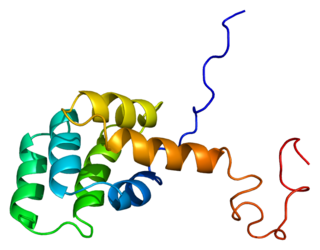CASP8 and FADD-like apoptosis regulator is a protein that in humans is encoded by the CFLAR gene. [5] [6] Also called c-FLIP (FLICE-like inhibitory protein).
CASP8 and FADD-like apoptosis regulator is a protein that in humans is encoded by the CFLAR gene. [5] [6] Also called c-FLIP (FLICE-like inhibitory protein).

Fas ligand is a type-II transmembrane protein expressed on various types of cells, including cytotoxic T lymphocytes, monocytes, neutrophils, breast epithelial cells, vascular endothelial cells and natural killer (NK) cells. It binds with its receptor, called FAS receptor and plays a crucial role in the regulation of the immune system and in induction of apoptosis, a programmed cell death.

The Fas receptor, also known as Fas, FasR, apoptosis antigen 1, cluster of differentiation 95 (CD95) or tumor necrosis factor receptor superfamily member 6 (TNFRSF6), is a protein that in humans is encoded by the FAS gene. Fas was first identified using a monoclonal antibody generated by immunizing mice with the FS-7 cell line. Thus, the name Fas is derived from FS-7-associated surface antigen.

The death-inducing signaling complex or DISC is a multi-protein complex formed by members of the death receptor family of apoptosis-inducing cellular receptors. A typical example is FasR, which forms the DISC upon trimerization as a result of its ligand (FasL) binding. The DISC is composed of the death receptor, FADD, and caspase 8. It transduces a downstream signal cascade resulting in apoptosis.

FAS-associated death domain protein, also called MORT1, is encoded by the FADD gene on the 11q13.3 region of chromosome 11 in humans.

Caspase-8 is a caspase protein, encoded by the CASP8 gene. It most likely acts upon caspase-3. CASP8 orthologs have been identified in numerous mammals for which complete genome data are available. These unique orthologs are also present in birds.

Caspase-7, apoptosis-related cysteine peptidase, also known as CASP7, is a human protein encoded by the CASP7 gene. CASP7 orthologs have been identified in nearly all mammals for which complete genome data are available. Unique orthologs are also present in birds, lizards, lissamphibians, and teleosts.

Death receptor 4 (DR4), also known as TRAIL receptor 1 (TRAILR1) and tumor necrosis factor receptor superfamily member 10A (TNFRSF10A), is a cell surface receptor of the TNF-receptor superfamily that binds TRAIL and mediates apoptosis.

Hypoxia-inducible factor 3 alpha is a protein that in humans is encoded by the HIF3A gene.

Nuclear factor of activated T-cells, cytoplasmic 3 is a protein that in humans is encoded by the NFATC3 gene.

Class E basic helix-loop-helix protein 40 is a protein that in humans is encoded by the BHLHE40 gene.

Inhibitor of growth protein 2 is a protein that in humans is encoded by the ING2 gene.

Death-associated protein kinase 3 is an enzyme that in humans is encoded by the DAPK3 gene.

CASP8-associated protein 2 is a protein, that in humans is encoded by the CASP8AP2 gene.

Fas-activated serine/threonine kinase is an enzyme that in humans is encoded by the FASTK gene.

Apoptosis facilitator Bcl-2-like protein 14 is a protein that in humans is encoded by the BCL2L14 gene.

Bcl-2-like protein 10 is a protein that in humans is encoded by the BCL2L10 gene.

Bcl-2/adenovirus E1B 19 kDa-interacting protein 2-like protein is a protein that in humans is encoded by the BNIPL gene.

Thioredoxin domain-containing protein 5 is a protein that in humans is encoded by the TXNDC5 gene.

Bcl-2-like protein 12 is a protein that in humans is encoded by the BCL2L12 gene.

Regulator of microtubule dynamics protein 3 (RMDN3), more commonly known as Protein tyrosine phosphatase interacting protein 51 (PTPIP51), is a protein that in humans is encoded by the RMDN3 gene on chromosome 15. This protein contributes to multiple biological functions, including cellular differentiation, proliferation, motility, cytoskeleton formation, and apoptosis, and has been associated with numerous cancers.